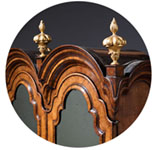18th Century George III Mahogany Serpentine Chest or Commode
Attributed to Henry Hill, Marlbrough
SOLD
Request Information
Follow Us
18th Century George III Mahogany Serpentine Chest or Commode
A fine George III mahogany serpentine commode, England, circa 1770. Attributed to Henry Hill, Marlbrough.
The three graduated drawers retain their original gilt brass handles over a unique carved apron and flanked by molded angles continuing into the shaped cabriole feet. The chest is in superb and original country house condition.
Attribution
Henry Hill was active in Marlborough Wiltshire from circa 1740 until his death in 1778 where he ran a diverse business encompassing furniture making, coach making, house agency and auctioneering. He was described in his obituary in 1778 as ‘one of the most eminent cabinet-makers and upholsterers in the Kingdom’ which was considered a great tribute to a cabinet maker working outside London. His clients were predominately Wiltshire landowners including the 9th Duke of Somerset at Maiden Bradley, Paul Methuen at Corsham Court, Henry Hoare at Stourhead, and Earl Bathurst at Cirencester Park. Hill was clearly aware of the prevailing London fashions and would have had access to publications including Chippendale’s designs for French Commode Tables (The Gentleman and Cabinet-Maker’s Director 1st Edition1754; Plate LXVI 3rd Edition 1763). He was also known to have employed immigrant labour (most likely German). All this is reflected in the designs of his furniture. His French Commodes were made with a number of variations dependent on his clients’ needs and budgets but invariably with three drawers and of serpentine form with flame figured veneers or marquetry, ormolu-mounted corners and a lobed front apron. The most documented commissions were for Lord Delaval (see bombe marquetry commode sold Bonhams London 19 October 2011). It seems likely that Hill had contact with Pierre Langlois with some of the mounts on his commodes being attributed to Langlois.
Condition
Fabulous and original country house condition with richly patinated surfaces!
Provenance
The provenance of this chest is also very interesting as it belonged to the late Major General Mark Bond, who was the last member of the Bond family to live at Moigne Combe. General Bond had an illustrious military career; he enlisted as a rifleman in 1940 following the Blitz of London. Major-General Bond served at the Battle of El-Alamein and the capture of Tunis. In 1943 Mark Bond was taken as a POW but managed to pull off a daring escape from his transport train. He was only recaptured after trying to steal supplies from the Germans. Major-General Mark Bond also served as aide de camp to Field Marshal Montgomery, NATO Deputy Supreme Allied Commander in Europe 1950. A letter from Field Marshal Montgomery thanking Mark Bond for his service is present at Moigne Combe. During his fascinating life he had a distinguished military career, held prestigious Dorset offices and maintained an active approach to conservation (planting over 60,000 trees on his estate).
Literature
Dimensions
PREVIOUSLY SOLD
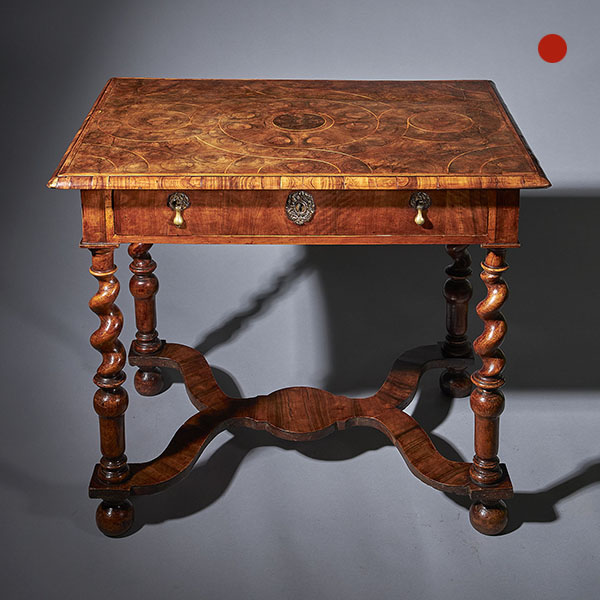
William and Mary Olive Oyster 31” Table
An exceptional and extremely rare William and Mary Olive Oyster 31” Table, Circa 1670-1690. Inlaid with holly the moulded and banded top sits above a frieze drawer, beautifully raised on original freely carved Solomonic or twist legs, terminate on reverse pears and joined by ‘y’ shaped stretcher veneered in cross-grain olive.

17th Century Charles II Olive Oyster Floral Marquetry Table, Circa 1680-1690
17th Century Charles II Olive Oyster Floral Marquetry Table, Circa 1680-1690 SoldFollow Us17th Century Charles II Olive Oyster Floral Marquetry Table, Circa 1680-1690 Floral marquetry inlaid olive oyster and ebony side table, attributed to...

18th Century George I Walnut Shepherds Crook Arm Chair with Period Needlework
18th Century George I Walnut Shepherds Crook Arm Chair with Period Needlework Sold[wpforms_selector form_id="11387" show_title="on" _builder_version="4.22.1" _module_preset="default" custom_margin="-30px||||false|false"...
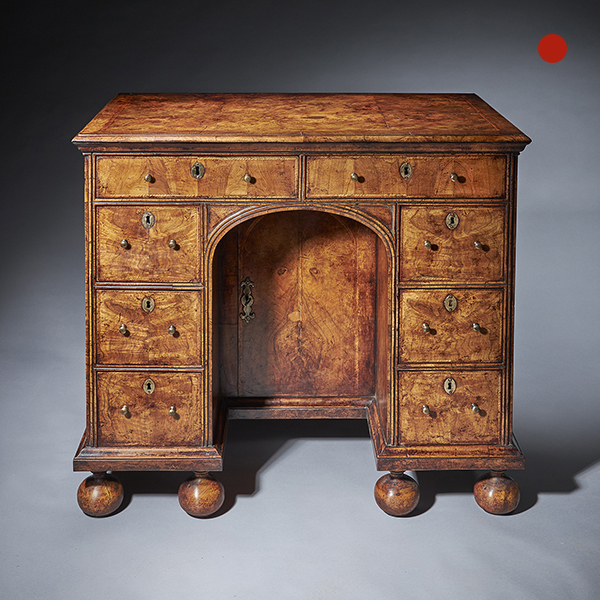
Queen Anne Walnut Kneehole Desk
The fine and rare Queen Anne (1702-1714) burr and highly figured walnut kneehole desk.
Above six solid walnut bun feet and cross-grain ogee moulding, six small drawers surround a double dee moulded edged kneehole under two long drawers
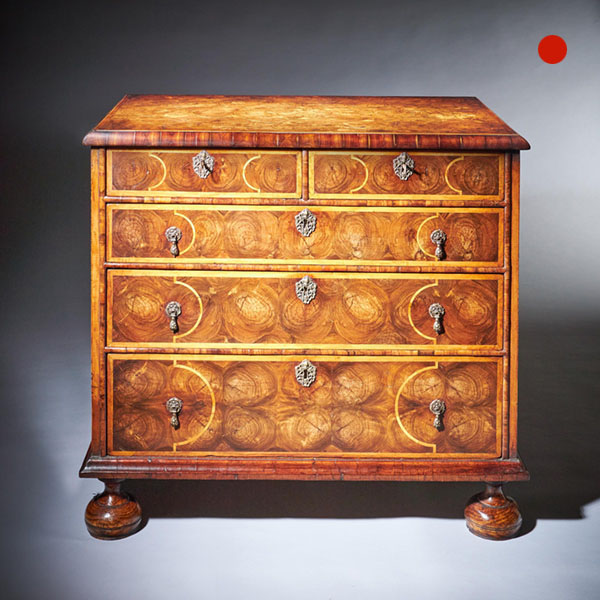
A Fine William and Mary Olive Oyster and Laburnum Chest, Circa 1680-1700
A Fine William and Mary Olive Oyster and Laburnum Chest, Circa 1680-1700 SoldFollow UsA Fine William and Mary Olive Oyster and Laburnum Chest, Circa 1680-1700 The rectangular cross-grain Laburnum moulded holly banded top is veneered in...
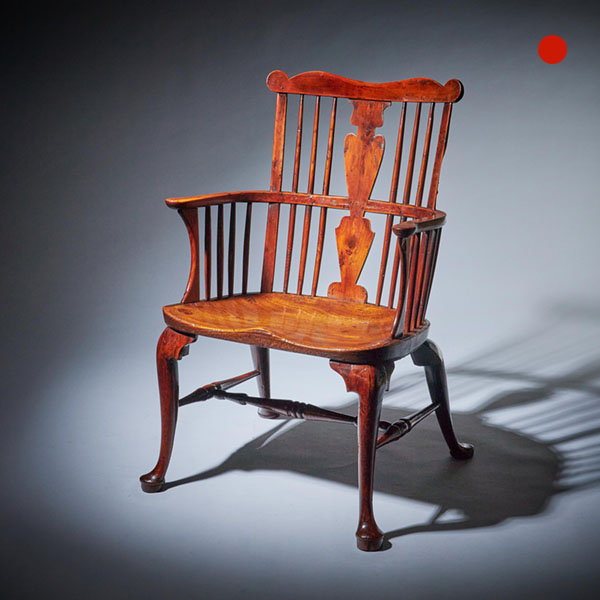
18th Century George III Yew and Elm Thames Valley Comb-Back Windsor Chair
18th Century George III Yew and Elm Thames Valley Comb-Back Windsor Chair SoldFollow Us18th Century George III Yew and Elm Thames Valley Comb-Back Windsor Chair The exceptional and rare yew and elm comb-back Regional Windsor chair of large...

William and Mary Olive Oyster 31” Table
An exceptional and extremely rare William and Mary Olive Oyster 31” Table, Circa 1670-1690. Inlaid with holly the moulded and banded top sits above a frieze drawer, beautifully raised on original freely carved Solomonic or twist legs, terminate on reverse pears and joined by ‘y’ shaped stretcher veneered in cross-grain olive.

17th Century Charles II Olive Oyster Floral Marquetry Table, Circa 1680-1690
17th Century Charles II Olive Oyster Floral Marquetry Table, Circa 1680-1690 SoldFollow Us17th Century Charles II Olive Oyster Floral Marquetry Table, Circa 1680-1690 Floral marquetry inlaid olive oyster and ebony side table, attributed to...

18th Century George I Walnut Shepherds Crook Arm Chair with Period Needlework
18th Century George I Walnut Shepherds Crook Arm Chair with Period Needlework Sold[wpforms_selector form_id="11387" show_title="on" _builder_version="4.22.1" _module_preset="default" custom_margin="-30px||||false|false"...

Queen Anne Walnut Kneehole Desk
The fine and rare Queen Anne (1702-1714) burr and highly figured walnut kneehole desk.
Above six solid walnut bun feet and cross-grain ogee moulding, six small drawers surround a double dee moulded edged kneehole under two long drawers

A Fine William and Mary Olive Oyster and Laburnum Chest, Circa 1680-1700
A Fine William and Mary Olive Oyster and Laburnum Chest, Circa 1680-1700 SoldFollow UsA Fine William and Mary Olive Oyster and Laburnum Chest, Circa 1680-1700 The rectangular cross-grain Laburnum moulded holly banded top is veneered in...

18th Century George III Yew and Elm Thames Valley Comb-Back Windsor Chair
18th Century George III Yew and Elm Thames Valley Comb-Back Windsor Chair SoldFollow Us18th Century George III Yew and Elm Thames Valley Comb-Back Windsor Chair The exceptional and rare yew and elm comb-back Regional Windsor chair of large...
YOU MAY ALSO LIKE
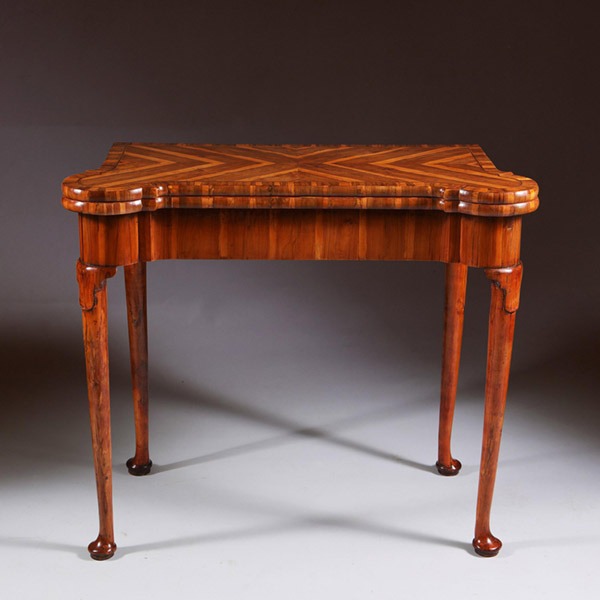
Museum Grade George I Cocus Wood Card Table, Circa 1725, England
Museum Grade George I Cocus Wood Card Table, Circa 1725. England £32,000Follow UsMuseum Grade...
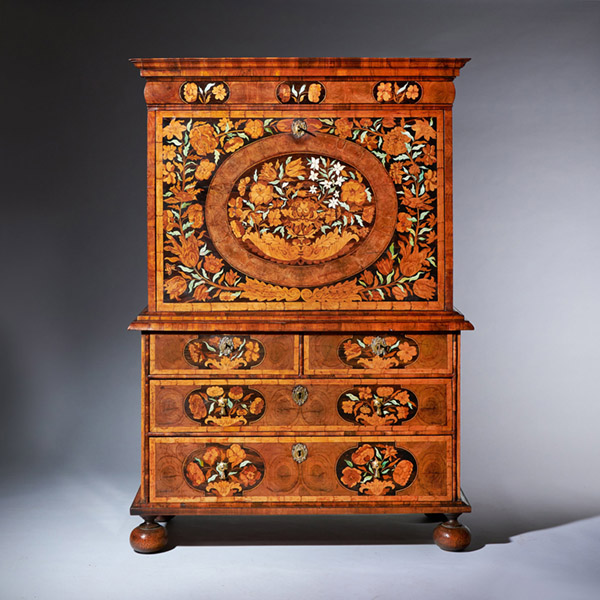
17th Century William and Mary Olive Oyster Marquetry Escritoire, Circa 1680
17th Century William and Mary Olive Oyster Marquetry Escritoire, Circa 1680 £60,000[wpforms_selector form_id="11387" show_title="on" _builder_version="4.22.1" _module_preset="default" custom_margin="-30px||||false|false"...

Fine Two-Day Marine Chronometer Signed Charles Frodsham
Fine Two-Day Marine Chronometer Signed Charles Frodsham £6,500Follow UsFine Two-Day Marine...
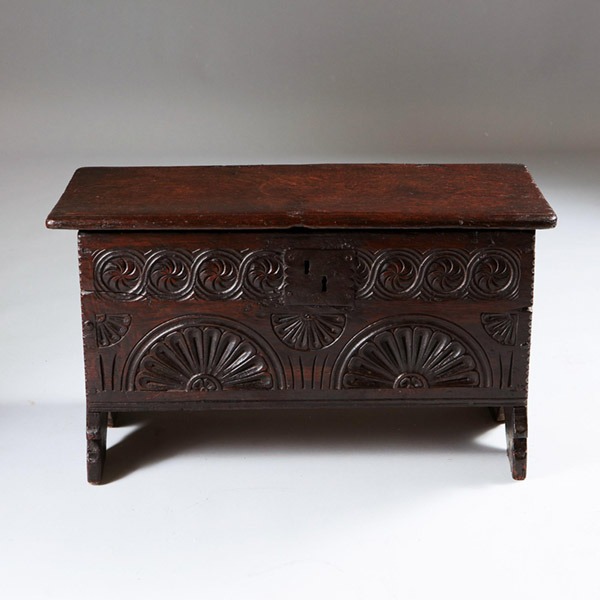
A Rare 17th Century Charles II Carved Oak Childs Coffer of Diminutive Proportion
A Rare 17th Century Charles II Carved Oak Childs Coffer of Diminutive Proportion £2,800Follow UsA...

A Rare and Important Charles II 17th Century Table Clock by Henry Jones
A Rare and Important Charles II 17th Century Table Clock by Henry Jones £85,000Follow UsA Rare and...
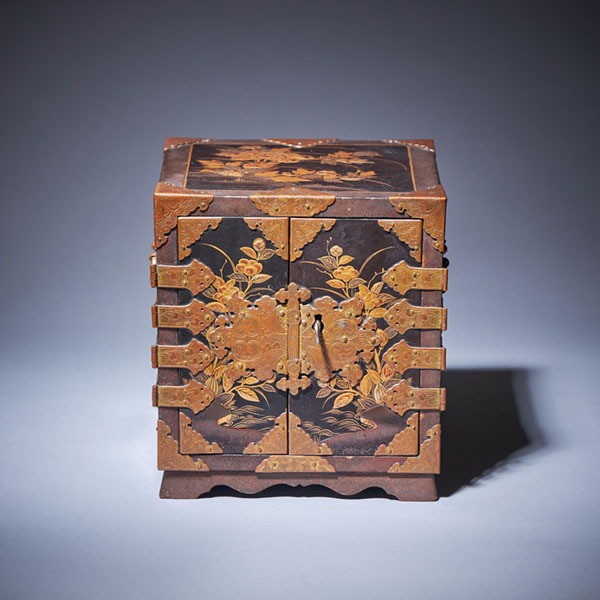
Important Early Edo Period 17th Century Miniature Japanese Lacquer Cabinet
Important Early Edo Period 17th Century Miniature Japanese Lacquer Cabinet £36,000Follow...

Museum Grade George I Cocus Wood Card Table, Circa 1725, England
Museum Grade George I Cocus Wood Card Table, Circa 1725. England £32,000Follow UsMuseum Grade...

17th Century William and Mary Olive Oyster Marquetry Escritoire, Circa 1680
17th Century William and Mary Olive Oyster Marquetry Escritoire, Circa 1680 £60,000[wpforms_selector form_id="11387" show_title="on" _builder_version="4.22.1" _module_preset="default" custom_margin="-30px||||false|false"...

Fine Two-Day Marine Chronometer Signed Charles Frodsham
Fine Two-Day Marine Chronometer Signed Charles Frodsham £6,500Follow UsFine Two-Day Marine...

A Rare 17th Century Charles II Carved Oak Childs Coffer of Diminutive Proportion
A Rare 17th Century Charles II Carved Oak Childs Coffer of Diminutive Proportion £2,800Follow UsA...

A Rare and Important Charles II 17th Century Table Clock by Henry Jones
A Rare and Important Charles II 17th Century Table Clock by Henry Jones £85,000Follow UsA Rare and...

Important Early Edo Period 17th Century Miniature Japanese Lacquer Cabinet
Important Early Edo Period 17th Century Miniature Japanese Lacquer Cabinet £36,000Follow...
